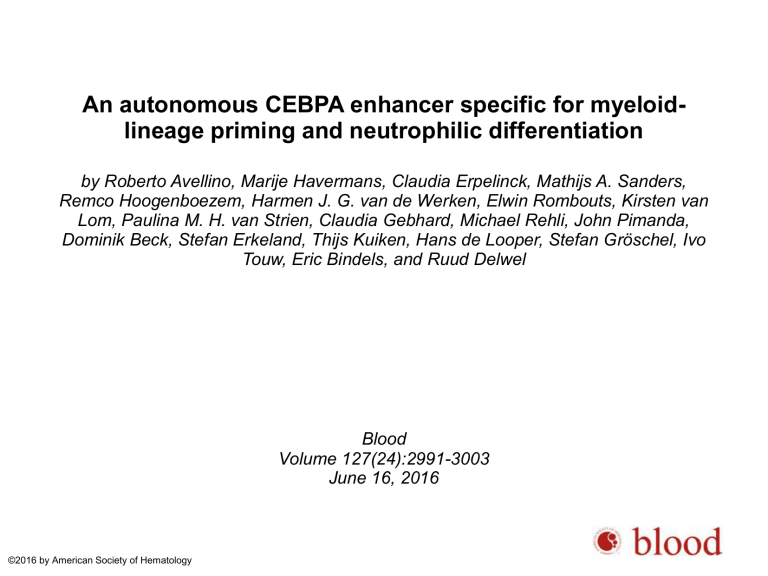
An autonomous CEBPA enhancer specific for myeloidlineage priming and neutrophilic differentiation
by Roberto Avellino, Marije Havermans, Claudia Erpelinck, Mathijs A. Sanders,
Remco Hoogenboezem, Harmen J. G. van de Werken, Elwin Rombouts, Kirsten van
Lom, Paulina M. H. van Strien, Claudia Gebhard, Michael Rehli, John Pimanda,
Dominik Beck, Stefan Erkeland, Thijs Kuiken, Hans de Looper, Stefan Gröschel, Ivo
Touw, Eric Bindels, and Ruud Delwel
Blood
Volume 127(24):2991-3003
June 16, 2016
©2016 by American Society of Hematology
The CEBPA promoter contacts multiple intra-TAD genomic sites.
Roberto Avellino et al. Blood 2016;127:2991-3003
©2016 by American Society of Hematology
The CEBPA TAD exhibits a diverse combination of active enhancers in different CEBPA+ tissues.
Roberto Avellino et al. Blood 2016;127:2991-3003
©2016 by American Society of Hematology
The +42-kb region is specifically H3K27ac marked in CD34+ HSCs. (A) CEBPA mRNA expression
determined by qPCR in FACS-sorted populations of normal CD34+ bone marrow cells,
metamyelocytes, and neutrophils (n = 3).
Roberto Avellino et al. Blood 2016;127:2991-3003
©2016 by American Society of Hematology
The +42-kb enhancer is a myeloid-specific CEBPA transcriptional activator.
Roberto Avellino et al. Blood 2016;127:2991-3003
©2016 by American Society of Hematology
+37-kb deleted mice (+42Mkb) show low Cebpa levels and develop neutropenia.
Roberto Avellino et al. Blood 2016;127:2991-3003
©2016 by American Society of Hematology
Reduction in GMPs, increase in CMPs, and loss of GCSF response in +42Mkb enhancer deleted
bone marrow.
Roberto Avellino et al. Blood 2016;127:2991-3003
©2016 by American Society of Hematology
Loss of HSCs and expansion of multipotent progenitors in +42M kb−/− mice.
Roberto Avellino et al. Blood 2016;127:2991-3003
©2016 by American Society of Hematology
